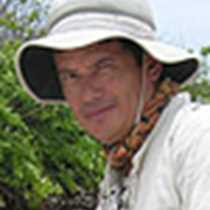Santa Cruz Island
Located at the central part of the Galápagos, Santa Cruz is one of the most beautiful islands and is the second largest in the archipelago. Early in the morning we dropped anchor in Indefatigable Bay and after breakfast we headed to Puerto Ayora, the town that is home of the Charles Darwin Station and the headquarters of the Galápagos National Park Service.
We disembarked at eight o’clock, and by bus we arrived to the Darwin Station. We walked along a trail where we observed the typical ever green vegetation such as mangroves, salt bushes, acacia and poison apple tree; finally we arrive to the giant tortoises’ corrals. From many different islands, we appreciated their differences; some of them smaller with saddleback carapace and the biggest with dome carapace. This emblematic creature captivated our attention, especially Diego, the giant tortoise who was taken from Española Island more than one hundred years ago, and responsible for the increment of population from 14 individuals in the 1960’s to more than 2000 nowadays.
After visiting the Darwin Station, our guests had time for visiting the town, and finally at 11:30 we headed to the highlands to have lunch enjoying nature. Driving to the highlands, the landscape was changing radically. We crossed the arid zone with its grey and dry trees and in no more than 10 minutes we saw another landscape and felt as the temperature decreased considerably as if we would be transported to another place. Certainly, we ascended more than 400m above the sea level in no more than 40 minutes, but nature needed maybe millions of years to make this marvelous place.
As soon we got to the restaurant and before lunch, we crossed a lava tunnel, where we appreciated how active this island was when it had volcanoes. Into the tunnel all was humid, and the reason was because water was leaking from the top – the night before it was raining. It was incredible to observe plants living in the tunnel using artificial light instead of the sun and nutrients as a result of the organic material that filtrated from the top.
After lunch, we visited the giant tortoises in the wild. They were all roaming gracefully or resting in muddy ponds; our guest took many pictures of them, walking freely along the green vegetation. Finally, the last stop was in los gemelos or the pit craters. Located at more than 550 meters above the sea level and colder than the giant tortoises’ area, this place is special, because we observed the remains of two volcanoes which magma chambers collapsed and the highway incredibly crosses in between of them. We crossed a forest of Scalesia Pedunculata trees, an endemic species related with the daisies and only found on Galápagos.
On trees, finches and mockingbirds sang and flew freely and afterwards, our guests finally headed to the town tired but very happy, because really today was a great day.




